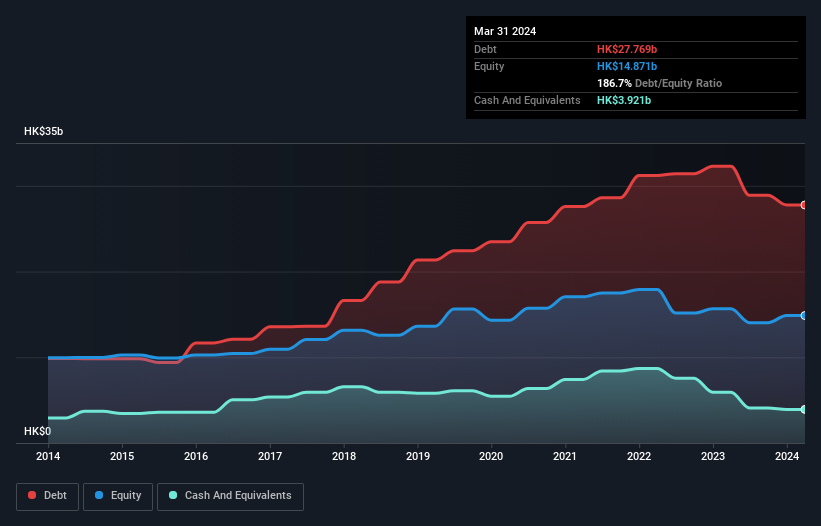- Hong Kong
- /
- Real Estate
- /
- SEHK:35
We Think Far East Consortium International (HKG:35) Is Taking Some Risk With Its Debt

Howard Marks put it nicely when he said that, rather than worrying about share price volatility, 'The possibility of permanent loss is the risk I worry about... and every practical investor I know worries about.' So it might be obvious that you need to consider debt, when you think about how risky any given stock is, because too much debt can sink a company. We note that Far East Consortium International Limited (HKG:35) does have debt on its balance sheet. But the real question is whether this debt is making the company risky.
When Is Debt Dangerous?
Generally speaking, debt only becomes a real problem when a company can't easily pay it off, either by raising capital or with its own cash flow. Part and parcel of capitalism is the process of 'creative destruction' where failed businesses are mercilessly liquidated by their bankers. However, a more frequent (but still costly) occurrence is where a company must issue shares at bargain-basement prices, permanently diluting shareholders, just to shore up its balance sheet. By replacing dilution, though, debt can be an extremely good tool for businesses that need capital to invest in growth at high rates of return. The first thing to do when considering how much debt a business uses is to look at its cash and debt together.
View our latest analysis for Far East Consortium International
What Is Far East Consortium International's Net Debt?
The image below, which you can click on for greater detail, shows that Far East Consortium International had debt of HK$27.8b at the end of March 2024, a reduction from HK$32.3b over a year. However, because it has a cash reserve of HK$3.92b, its net debt is less, at about HK$23.8b.

How Strong Is Far East Consortium International's Balance Sheet?
We can see from the most recent balance sheet that Far East Consortium International had liabilities of HK$16.2b falling due within a year, and liabilities of HK$16.2b due beyond that. On the other hand, it had cash of HK$3.92b and HK$2.00b worth of receivables due within a year. So it has liabilities totalling HK$26.5b more than its cash and near-term receivables, combined.
The deficiency here weighs heavily on the HK$3.41b company itself, as if a child were struggling under the weight of an enormous back-pack full of books, his sports gear, and a trumpet. So we'd watch its balance sheet closely, without a doubt. After all, Far East Consortium International would likely require a major re-capitalisation if it had to pay its creditors today.
We use two main ratios to inform us about debt levels relative to earnings. The first is net debt divided by earnings before interest, tax, depreciation, and amortization (EBITDA), while the second is how many times its earnings before interest and tax (EBIT) covers its interest expense (or its interest cover, for short). The advantage of this approach is that we take into account both the absolute quantum of debt (with net debt to EBITDA) and the actual interest expenses associated with that debt (with its interest cover ratio).
Strangely Far East Consortium International has a sky high EBITDA ratio of 16.2, implying high debt, but a strong interest coverage of 34.0. So either it has access to very cheap long term debt or that interest expense is going to grow! Pleasingly, Far East Consortium International is growing its EBIT faster than former Australian PM Bob Hawke downs a yard glass, boasting a 171% gain in the last twelve months. The balance sheet is clearly the area to focus on when you are analysing debt. But ultimately the future profitability of the business will decide if Far East Consortium International can strengthen its balance sheet over time. So if you're focused on the future you can check out this free report showing analyst profit forecasts.
But our final consideration is also important, because a company cannot pay debt with paper profits; it needs cold hard cash. So we always check how much of that EBIT is translated into free cash flow. Considering the last three years, Far East Consortium International actually recorded a cash outflow, overall. Debt is usually more expensive, and almost always more risky in the hands of a company with negative free cash flow. Shareholders ought to hope for an improvement.
Our View
To be frank both Far East Consortium International's net debt to EBITDA and its track record of staying on top of its total liabilities make us rather uncomfortable with its debt levels. But at least it's pretty decent at covering its interest expense with its EBIT; that's encouraging. Overall, we think it's fair to say that Far East Consortium International has enough debt that there are some real risks around the balance sheet. If everything goes well that may pay off but the downside of this debt is a greater risk of permanent losses. When analysing debt levels, the balance sheet is the obvious place to start. But ultimately, every company can contain risks that exist outside of the balance sheet. We've identified 4 warning signs with Far East Consortium International (at least 1 which is significant) , and understanding them should be part of your investment process.
Of course, if you're the type of investor who prefers buying stocks without the burden of debt, then don't hesitate to discover our exclusive list of net cash growth stocks, today.
New: AI Stock Screener & Alerts
Our new AI Stock Screener scans the market every day to uncover opportunities.
• Dividend Powerhouses (3%+ Yield)
• Undervalued Small Caps with Insider Buying
• High growth Tech and AI Companies
Or build your own from over 50 metrics.
Have feedback on this article? Concerned about the content? Get in touch with us directly. Alternatively, email editorial-team (at) simplywallst.com.
This article by Simply Wall St is general in nature. We provide commentary based on historical data and analyst forecasts only using an unbiased methodology and our articles are not intended to be financial advice. It does not constitute a recommendation to buy or sell any stock, and does not take account of your objectives, or your financial situation. We aim to bring you long-term focused analysis driven by fundamental data. Note that our analysis may not factor in the latest price-sensitive company announcements or qualitative material. Simply Wall St has no position in any stocks mentioned.
About SEHK:35
Far East Consortium International
An investment holding company, engages in the property development and investment activities in Australia, New Zealand, the Czech Republic, Hong Kong, Malaysia, the People’s Republic of China, Singapore, the United Kingdom, and the rest of Europe.
Undervalued with mediocre balance sheet.
Similar Companies
Market Insights
Community Narratives



